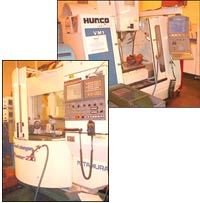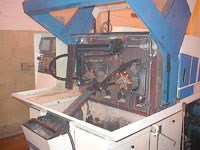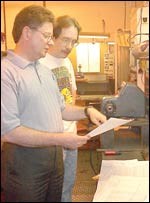Get Lean, Go Global
A successful manufacturing company must achieve world-class capability within its walls. At the same time, a company has to go after global business opportunities. Hanel Corporation (New Berlin, Wisconsin) is a case in point. It has implemented several U-shaped production cells that help the company keep costs down and productivity up. At the same time, company leaders have aggressively courted customers in countries around the world by offering both tangible and intangible values.
Competitiveness has an "inside" and "outside" aspect. On the inside, Hanel Corporation has the look of a lean but flexible parts manufacturer. It seeks out waste and drives it down relentlessly. To the outside world, the company has made itself known for close-tolerance machining and quick turnaround. "To the outside world" is no mere figure of speech: Hanel actively seeks customers across the globe and courts them patiently, persistently.
Many U.S. companies the size of Hanel (60+ employees; annual sales around $7 million) miss out because they fail to excel in both the inside and outside aspects. These companies do not fulfill their potential to be thoroughly competitive, inside and out.
According to Mark Strehlow, president and general manager of Hanel, a successful manufacturing company must achieve world-class capability within its walls. At the same time, he says, a company has to go after global business opportunities. "Manufacturing companies have to work hard in both directions at once. One-sided companies will have a more difficult time surviving," he says. He firmly believes that U.S. companies have a future in manufacturing to the extent that they attain this inside/outside competitiveness.
Of course, he sees his own company as a case in point. Hanel's manufacturing facility in New Berlin, Wisconsin, has implemented several U-shaped production cells. These cells demonstrate many of the core principles that help the company keep costs down and productivity up. They also represent the core capability that Mr. Strehlow has been able to market to international customers in countries such as Sweden and the United Kingdom, as well as to win U.S. customers such as Eaton, Caterpillar, John Deere and others. "Lean manufacturing doesn't happen by itself," he explains. "Getting business from overseas doesn't happen on its own, either."
Leveling On A Roll
Hanel has been in business since 1957. Started by Al Hanel to do prototype work, the company established a good reputation for quality and delivery. The shop incorporated in 1963 as it grew steadily. Mr. Strehlow joined the company in 1977 as a prototype machinist and worked his way up to vice president of operations, getting an engineering education along the way. He is now a partner who shares company ownership with Rob Hanel and Dennis Hanel.
The company moved into its current location in a suburban industrial park outside Milwaukee in 1975. Today, the company's specialty is hydraulic flow components, particularly turned parts such as brake pistons, directional valves and spools, although block-shaped parts such as hydraulic manifolds and valve bodies that are drilled and milled on machining centers are the latest growth area.
According to Mr. Strehlow, the company began to move to a horseshoe-shaped arrangement of production cells in 1996. Each cell also follows a basic U shape. The idea is to avoid the crisscross flow of workpieces common in traditional manufacturing layouts that are divided into separate departments focused on a specific process. This old arrangement relied on staging areas and queues of inventory for movement of workpieces.
Cells, by contrast, allow parts to flow from process to process, ideally with one part moving from machine to machine with no batching in between. Mr. Strehlow describes this cellular manufacturing principle as "arranging equipment and workstations in process sequence to support smooth flow of materials and components with minimal transport or delay." More colorfully, he says that the idea is to flow parts from process to process "at the speed of chips."
Because Hanel is a contract manufacturer, however, cells have to be flexible enough to accommodate variations in the manufacturing sequence. This makes cellular manufacturing a challenge that is different from those encountered when creating cells in a product-line manufacturing setting. Hanel provides this requirement for flexibility by putting certain machine tools on wheeled bases so that they can be rolled in and out as needed.
The key to properly configuring each cell is synchronizing the turning and milling operations. By synchronizing these operations, parts can flow without batching. The great thing about lean manufacturing, Mr. Strehlow stresses, is that it provides tools that take the guesswork out of synchronizing and pacing the processes in the cell. One of these tools is takt time. "Takt time is the rate at which the cell has to produce a finished part to meet our delivery requirements," he says. "Takt time as a measure of productivity also helps determine if cost goals are being met."
Takt time helps the shop pick the right "transportable" machine and divide up operations in the cell. The cell's configuration has to allow parts to flow at the rate determined by the takt time (including provisions for setup, change-over and scheduled downtime). Moreover, part flow must be level. In other words, the production rates at each machine must be balanced so that no process will get ahead or fall behind the others. Level production keeps parts from piling up when moving from a faster process to the slower one, or causing idle time when moving from the slower process to the faster one.
A look at a typical cell in place at Hanel shows how this works. The cell produces a family of flow control spools for hydraulic valves. Each part requires a number of turning and milling/drilling operations, so the core of the cell consists of a Swiss-type CNC automatic lathe and a vertical machining center with a dual-station rotary pallet system. For this part family, the non-turning operations are more complex and time consuming than the turning operations. Various contours, notches and cross-holes must be produced on the spools, and these features account for the greatest variation between members of the part family.
The main turning machine is a CNC automatic from Manurhin K'MX (Mulhouse, France), as shown on page 65. Material enters the cell at this machine and undergoes most of the OD work and some ID work on the front end. The sliding headstock on this machine allows turning operations to occur very close to the spindle nose, where support is the most rigid. Two tool turrets on the transverse axes are located radially around the spindle nose and can feed in simultaneously. According to Mr. Strehlow, this machine holds tolerances to ±0.0003 inch or better.
All six tool turrets on the right-hand turret can be driven. This provision for live tooling allows some milling or drilling operations to be performed on this machine, an option that can be considered in cases where "slowing down" the turning cycle time helps level production. The slower cycle time, however, is only an appearance, because the time is made up by "faster" cycle times at other machines in the cell that no longer have to perform those operations.
Turning operations are completed on a GT-Jr. Series I lathe from OmniTurn (Famingdale, New York). Additional OD operations are performed on this machine, as are ID and face turning of the cutoff end. This machine is mounted on a wheeled platform, so an additional or alternative machine could be incorporated into the cell. The flexibility of these transportable machines creates numerous options for leveling the flow of parts through the turning operations.
An inspection station opposite the Swiss-type machine allows samples to be measured before the parts move to the machining centers.
A Mycenter 2Xi from Kitamura Machinery of USA (Wheeling, Illinois) provides the main machining center capability in the cell. This machine is equipped with a dual-station pallet system. As one part is machined, the other station is loaded and unloaded to minimize non-cutting time. Because machining center work takes considerably longer than turning, a second machining center has been moved into the cell so that milling and drilling can keep up with the pace set by the Swiss machine. In this case, the second machining center is a VM1 from Hurco (Indianapolis, Indiana). According to Mr. Strehlow, this machine does not have a pallet changer, so its cycle times do not quite match those of the pallet-equipped machine. What is important is that the combined output of these machines hits the takt time target.
Lean Support
To a visitor's first glance, this cell seems very cramped, but there is a reason for crowding the machines together. "The cell operator has the least distance to carry a part this way," explains Mr. Strehlow. The operator can pivot from one machine to another without unnecessary steps. The arrangement of the cell and the allocation of processing steps between the machines are largely left up to the cell operators. Essentially, the manufacturing engineers work out a basic process plan and determine takt times, then they let the shopfloor staff work out the details.
Hanel also relies on the shopfloor staff to conduct its own setup reduction events to achieve the takt time goals. On average, setup time is around 2 hours, compared to a 16- to 18-hour average 10 years ago, before cells were implemented. Sometimes it is necessary to conduct a full-blown setup reduction kaizen to reach a setup time in keeping with given takt times. This involves videotaping procedures, brainstorming to identify wasted time and movement, and implementing the planned streamlining.
5S (sort, shine, simplify, standardize and sustain) is the guiding principle for organizing the cell. The toolroom supports lean operations by delivering complete sets of preset tooling. Likewise, the inspection team provides support but does not measure or inspect workpieces. That happens strictly within each cell. The inspection team does provide the sampling and process control plan, however, making sure that QC data sheets accompany the kits of preset tooling.
International Flair
About 25 percent of Hanel's business comes from overseas customers. At the moment, a Swedish customer represents the bulk of this work, but current customers also include companies in England.
Mr. Strehlow leads the international selling effort himself. Eight years ago, as the company's efforts to implement lean manufacturing began to return significant savings in cost and delivery time, he could see that Hanel was winning jobs that were also bid on by companies from Europe and Asia. This was certainly clear evidence of Hanel's global competitiveness.
It was obvious to Mr. Strehlow that Hanel should be able to compete with these companies to win customers on their turf. He jumped in by finding names of likely customers from foreign trade journals and international directories. He quickly learned some important lessons. To succeed, he had to figure out what these prospective customers were really looking for and how they wanted to be approached. The correct approach varied from country to country, reflecting diverging cultural expectations.
What were these prospective overseas customers looking for? How could Hanel meet these needs? "Like customers everywhere, they are looking for value," Mr. Strehlow answers. He learned, however, that value means more than low cost, on-time delivery and consistent quality—the "tangible," measurable elements. Customers in other countries are also looking for "intangibles"—a sense of urgency in response to their specific needs, a willingness to understand the unique aspects of their businesses and a sincere concern for their special interests.
Mr. Strehlow says that these factors are just as important as the tangible elements, but they are much harder to convey as part of the total value package. "We can show a customer what we are doing to use raw material efficiently, reduce cycle times, avoid waste and scrap, and streamline production flow," he explains. "But demonstrating the intangibles requires a less direct approach."
This approach takes time, and it starts with the initial contact. Mr. Strehlow has made a point of learning key phrases and greetings in several foreign languages. These are practical for overcoming barriers that make it hard to reach the right decision-maker overseas. More importantly, using these phrases shows a willingness to meet his counterparts on a personal, equal basis.
Good listening skills are critical, too, he says. Getting accustomed to accented language is one thing, but getting beyond the literal meanings of words also counts. "You have to discern what a prospect is really looking for. It may be that a level of trust is a bigger issue than establishing technical competence," he says.
Being sensitive to cultural differences is another part of international communication that can't be neglected. Mr. Strehlow pays close attention to clues in e-mail messages and other correspondence to detect how someone wishes to be addressed or given other signs of respect, for example. Likewise, meetings tend to take place at certain times of the day, depending on customs that vary from country to country. This knowledge helps when trying to make contact by telephone.
Finally, one has to be patient. Building relationships with customers takes time. It took 2 years of exchanging messages and establishing a dialog with a company in Sweden before concluding a substantial, long-term order, Mr. Strehlow reports.
Yet all these skills are simply part of getting a good start. Working with international customers also requires that everyone in the organization uphold the same commitment to fulfilling tangible and intangible values. "A manufacturing engineer in Sweden has to find the same responsiveness and sense of urgency whether communicating with me or with someone on the shop floor," Mr. Strehlow says. That requires good communication and training among all employees.
Mr. Strehlow adds that developing a global network of customers has strengthened his company's relationship with its U.S. customers. Most of them source parts on a global basis, so they have learned to appreciate the same values and standards of conduct now demonstrated by Hanel.
Way Of Life
One key principle of lean manufacturing is that the cycle of identifying and getting rid of waste is never-ending. "It has to be a way of life from top to bottom," says Mr. Strehlow. The same principle applies to going after business anywhere and everywhere around the world. "It's a never-ending cycle of seeking out, nurturing and renewing relationships, no matter where in the world they originate," he says. This, too, is a way of life at Hanel Corporation.
Related Content
When Organic Growth in Your Machine Shop Isn’t Enough
Princeton Tool wanted to expand its portfolio, increase its West Coast presence, and become a stronger overall supplier. To accomplish all three goals at once, acquiring another machine shop became its best option.
Read MoreHow to Start a Swiss Machining Department From Scratch
When Shamrock Precision needed to cut production time of its bread-and-butter parts in half, it turned to a new type of machine tool and a new CAM system. Here’s how the company succeeded, despite the newness of it all.
Read MoreHow to Reduce Cycle Times by 70% and More on Your Existing CNCs and Dramatically Improve Tool Life Too
By employing advanced high efficiency milling techniques for the entire machining routine, SolidCAM’s iMachining technology can drastically reduce cycle times while vastly improving tool life compared to traditional milling.
Read MoreBuilding an Automation Solution From the Ground Up
IMTS 2022 provides visitors the opportunity to meet with product experts to design automation solutions from scratch.
Read MoreRead Next
3 Mistakes That Cause CNC Programs to Fail
Despite enhancements to manufacturing technology, there are still issues today that can cause programs to fail. These failures can cause lost time, scrapped parts, damaged machines and even injured operators.
Read MoreThe Cut Scene: The Finer Details of Large-Format Machining
Small details and features can have an outsized impact on large parts, such as Barbco’s collapsible utility drill head.
Read More.png;maxWidth=970;quality=90)


















.png;maxWidth=300;quality=90)

.png;maxWidth=300;quality=90)













